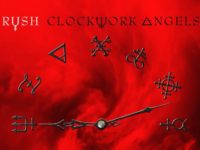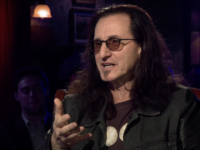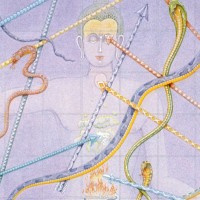Producer Nick Raskulinecz describes the sessions for Rush’s forthcoming 2012 release Clockwork Angels as jam-based affairs that then grew into finished songs — capped by a lightning strike moment when the theme came together.
Work began Rush’s first album in five years 2008, then took a hiatus two years later to undertake the “Time Machine” tour — which included 81 shows in North America, South America and Europe. The trio, which also includes Geddy Lee and Alex Lifeson, then reconvened last October to complete the project, with Raskulinecz helming his second project for Rush.
[SOMETHING ELSE! REWIND: We gathered at the SER Towers watercooler recently to share our first-take thoughts on “Headlong Flight,” the newest single from Rush’s forthcoming album ‘Clockwork Angels.’]
Over that time, the band has released three songs from the album, with the last arriving last month in front of an announced June 12 release date for Clockwork Angels. The seven-minute “Headlong Flight,” which was called “Take That Lampshade Off Yo’ Head” before the legendary trio added Neil Peart’s lyrics, is a perfect example of how the Rush sessions unfolded.
“Well, I should mention that every song was born out of a jam,” Raskulinecz tells Joe Bosso of Music Radar. “Geddy and Alex would sit in a room and jam with a click track or a simple drum beat. The songs were very different without Neil. So that was the first stage of the demos; the next demo stage was to get Neil on the songs.”
The cyclic nature of the sessions — held in 2008-10, and then again over a two-week period last year — meant that sometimes the band would split into two camps: Raskulinecz and Peart would be tracking drums on finished songs, while Lee and Lifeson continued tandem work on additional pieces of music.
“We did them lots of ways,” Raskulinecz says. “Some of it was them playing together, some of it was them playing individually, some of it was piece by piece. But all three of them were together throughout the entire process. For instance, we might get the bass and drums done, and then Alex and (engineer) Rich (Chycki) will go in one room and work on guitars while I’ll go to another room with Ged to do vocals. Different things were happening all the time.”
Finally, everything came together lyrically for Peart, and the album seemed to almost instantly coalesce into a finished product, Raskulinecz told Music Radar.
“One day, Neil walked in the room and said, ‘It’s done. I finished it,'” the producer says. “For the next 20 minutes, Neil talked about this vision he had for the concept of the record, and it was one of those moments I’ll never forget. Listening to him, watching him speak — it was amazing! I wish we were filming him so we could put it on YouTube. And right there, the whole record just clicked. Once Geddy and Al heard where Neil was going, they churned out some amazing music. I think ‘Headlong Flight’ came the next day.”
[amazon_enhanced asin=”B007I2BZIE” container=”” container_class=”” price=”All” background_color=”FFFFFF” link_color=”000000″ text_color=”0000FF” /] [amazon_enhanced asin=”B005D0RDIE” container=”” container_class=”” price=”All” background_color=”FFFFFF” link_color=”000000″ text_color=”0000FF” /] [amazon_enhanced asin=”B000C4BBZ2″ price=”All” background_color=”FFFFFF” link_color=”000000″ text_color=”0000FF” /] [amazon_enhanced asin=”B00569507I” /] [amazon_enhanced asin=”B000W1YYSQ” price=”All” background_color=”FFFFFF” link_color=”000000″ text_color=”0000FF” /]
Here’s a look back at our previous thoughts on Rush. Click through the titles for complete reviews …
RUSH – TIME MACHINE 2011: LIVE IN CLEVELAND (2011): Rush used this opportunity to, as they really have been doing each tour lately, rifle through catalog and pull out some dusty old gems (“Time Stand Still,” reggae “Working Man,” “Marathon,” “Subdivisions,” “Stick It Out” and “Leave That Thing Alone”) and even one bonafide “never been played before” fan favorite (“Presto”) but, most importantly, a run-through of their entire classic Moving Pictures album for its 30th anniversary. Some of those tunes have been played a lot (“Tom Sawyer,” “Limelight,” I’m looking at you) but others have disappeared for far, far too long. Welcome back to the stage “The Camera Eye” and “Witch Hunt.” Maybe you’ll stick around for a couple tours?
NEIL PEART – ANATOMY OF A DRUM SOLO (2005): On this two-disc set, we are treated to a complete deconstruction of the solo, recorded during the Rush 30th anniversary tour. Now, maybe this stuff is for drum wonks only, but I found it fascinating. Not just for the crazy amount of technique the man possesses. No, what makes this different is the sheer musicality woven through the solo. Neil is well-versed in the history of music and drops little bits of it into his work. There is plenty of bonus material to go around here, including some extended improvisations, full in-concert Rush tunes presented from the drums-only camera, the “O Baterista” solo from Rush In Rio, and a previously unreleased solo from the Counterparts tour.
SOMETHING ELSE! FEATURED ARTIST: RUSH: When most think of Rush, it’s their instrumental virtuosity (especially drummer Neil Peart) that comes to mind first. Or the love or hatred of Geddy Lee’s vocals. Other times it’s Peart’s second role as lyricist for the band that garners attention, and it’s another love or hate area of focus: Ayn Rand, sci-fi, songs about balding, fights between dogs and, well, whatever a Bytor is, these are all common targets for those who want to throw stones. We’re here to present an argument for the defense.
RUSH – ROLL THE BONES (1991; 2011 reissue): Listeners will hear immediately that the sound is indeed lighter and quieter, and the soundstage is thinner than either previous version. But it’s all to better show off the album’s immaculate recording, which does get a bit muffled in the Atlantic pressings. This is where you can revel in the tone of Geddy’s maturing voice, or the textures of Alex Lifeson’s guitar, or the layers of keyboard washes that are now magically so much more discernible from one another. With regard to those keyboard washes, what’s funny is that once you hear them here, you can’t help but notice them in the other versions, too. It just took this delicate audiophile edition to separate them out.
- Ernesto Cervini’s Turboprop, “When I Fall” (2024): Video premiere - March 15, 2024
- Disaster Pony,“Dead Neon & The Noon Sun” from ‘Disaster Pony’ (2024): Video premiere - February 27, 2024
- Christopher Hoffman, “Farewell Forever” from ‘Vision Is The Identity’ (2024): Streaming premiere - February 19, 2024




